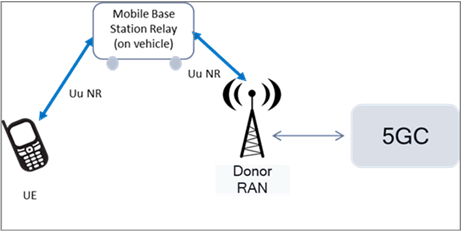Content for TR 22.839 Word version: 18.1.0
1 Scope
2 References
3 Definitions and abbreviations
3.1 Definitions
3.2 Abbreviations
4 Overview
...
...
1 Scope p. 8
The present document is the outcome of the study on use cases and potential new requirements for 5GS support of mobile base station relays mounted on vehicles, using 5G NR over the radio links toward UEs and macro RAN (connected to 5GC). This study covers aspects related to:
- Vehicle base station relays providing service to UEs inside the vehicle or in the vicinity of the vehicle;
- End-to-end service continuity during mobility scenarios (including mobility of the relays);
-
Provisioning, policies and control, e.g. for
- Provisioning of spectrum used by the relays, geographic area restrictions;
- Control of relay operation, UEs access and connectivity via relays.
- Aspects related to roaming of relays, security, regulatory requirements (e.g. for emergency services), charging, spectrum interference.
- Gap analysis between the identified requirements and existing 5GS requirements or functionalities.
2 References p. 8
The following documents contain provisions which, through reference in this text, constitute provisions of the present document.
- References are either specific (identified by date of publication, edition number, version number, etc.) or non-specific.
- For a specific reference, subsequent revisions do not apply.
- For a non-specific reference, the latest version applies. In the case of a reference to a 3GPP document (including a GSM document), a non-specific reference implicitly refers to the latest version of that document in the same Release as the present document.
3 Definitions and abbreviations p. 8
3.1 Definitions p. 8
For the purposes of the present document, the terms and definitions given in TR 21.905 and the following apply. A term defined in the present document takes precedence over the definition of the same term, if any, in TR 21.905.
3.2 Abbreviations p. 8
4 Overview p. 9
Demand for improved 5G cellular coverage and connectivity continues to increase, which may be challenging in many outdoor and mobility scenarios. In some outdoor environments, the availability of vehicles equipped with mobile base station relays, either following a certain known/predictable itinerary (e.g. buses, trams, etc), or situated in convenient locations (e.g. outside stadiums, hot-spot areas, or emergency sites), could provide very opportunistic boost to cellular coverage and capacity when/where needed. Those relays, using 5G wireless backhaul toward the macro network, could indeed offer better 5G coverage and connectivity to neighbouring UEs. Vehicle relays are obviously very suitable also for improving connectivity for users or devices inside the vehicle itself, in different environments, e.g. for passengers in buses, car/taxi, or trains, ad-hoc/professional personnel or equipment. Yet other target scenarios are where vehicle relays can be used for reaching users or devices that would otherwise have no or very poor macro coverage, e.g. in case of first responders dislocated in indoor buildings/areas, using 5G relays placed on their nearby/outside vehicles to get required 5G coverage and connectivity.
The technical benefits of using vehicle relays include, among others, the ability of the BS relay to get better macro coverage than a nearby UE, e.g exploiting better RF/antenna and power capabilities. Besides the value for network operators and end users, worthy incentives could be found for other parties as well, e.g. for vehicles manufacturers, vehicle/fleet owners or providers, to install and operate relays in their vehicles.
In the context of this TR, from a high-level 5G system point of view, the target scenarios include moving vehicles equipped with small on board base station (BS) relays providing 5G coverage and communication to UEs (inside the vehicle and/or in its vicinity), and connected wirelessly to the 5G network via RAN (donor) nodes.

As shown in the figure above, the main connectivity assumptions are:
- 5G NR is used for the radio link between mobile BS relay and donor RAN node, as well as the radio link between BS relay and UE.
- The mobile BS relay connects, via donor RAN node, to the 5G Core network (5GC).
- Single-hop relay is the main/baseline scenario (multi-hop can be a possible option)